In a bare, darkened interior, an elegantly dressed man sits at a table before an open book. Paused in his reading, he distractedly turns the cord of his collar between his fingers as his left hand rests on the book’s pages. Light catches the buttons and right sleeve of his fur trimmed tabard, a sixteenth-century garment associated with learning and the scholarly tradition, and delicately accents the refinements of his dress.1 The sitter’s plush black beret sits on soft waves of long hair and gently casts a shadow over the left side of his slightly blushed face. Bol rendered the man’s features with careful contrasts of light and dark, modeling his form against the deep brown background. The man’s considered state of intellectual contemplation, his sophisticated, historicizing costume, and the books lining the back wall situate him within the pictorial tradition of the scholar in his study.2
Images of a scholar in his study were popular in the seventeenth century. Rembrandt van Rijn (1606–69), with whom Bol studied in the late 1630s and early 1640s, treated the theme a number of times, as did Gerrit Dou (1613–75).3 For his image, Ferdinand Bol relied on the compositional model provided by Rembrandt in his 1635 etching of Johannes Uytenbogaert (fig 1), in which the prominent Remonstrant minister, dressed in a similar tabard and a black skullcap and seated before a table and large opened book, has paused from reading.4 Dou also followed this compositional model in the Leiden Collection’s Scholar Interrupted at His Writing (see GD-102), but he situated the elderly scholar in a more elaborate, defined setting containing the attributes of his profession.5 Finally, the work’s warm brown palette and chiaroscuro, which Bol achieved by building up the composition from light to dark, attests to the training he received with Rembrandt.6
Although Bol based his composition on Rembrandt’s portrait of Johannes Uytenbogaert, the character of his work differs considerably from its model. The scholar in Bol’s painting is a young man, his skin untouched by the wear of time, and he sits in a study devoid of all but the most essential attributes of the scholar: his books. Most significantly, instead of gazing out at the viewer, the scholar stares off to the side, allowing his thoughts to turn inward as he reflects upon the words on the page. The man’s preoccupied gesture reinforces this state of reflection and concentration. Bol’s careful depiction of the man’s features, the pages of the book, the soft texture of the fur collar, and the deep red of the tablecloth give added poignancy to this sensitive and original contribution to the tradition of the scholarly portrait.
The elegance of the sitter’s costume, including his jeweled, trimmed beret, or bonnet, is similar to that in Rembrandt’s Self-Portrait from 1640 in the National Gallery, London.7 Bol seems to have been inspired by the refined character of Rembrandt’s dress, which he combined with elements of the traditional academic costume. Bol’s interest in historicizing costumes is also evident in the inventive portraits that he produced in the 1640s and 1650s, such as the Leiden Collection’s Self-Portrait, behind a Parapet and Man with a Fur-Trimmed Hat (see FB-107 and FB-105).8
Bol depicted scholars on two more occasions in the late 1640s and early 1650s, in works in the Hermitage and the National Gallery, London.9 He maintained the basic compositional arrangement of Man with a Book, but he depicted these latter scholars at nearly full-length and turned in the viewer’s direction. In the National Gallery’s Astronomer (fig 2), executed in 1652, Bol included a more expansive interior. The scholar’s table contains both celestial and terrestrial globes, along with large books, which are casually propped up against one another.10 The astronomer pauses with his hand on his chin, an expression of concentrated intellectual activity that recalls that of the scholar in Man with a Book. In each instance, Bol combined his sensitive modeling of facial features with subtle, unconscious gestures to convey the inner life of his protagonists as they ponder the implications of ideas gained from their scholarly activities
